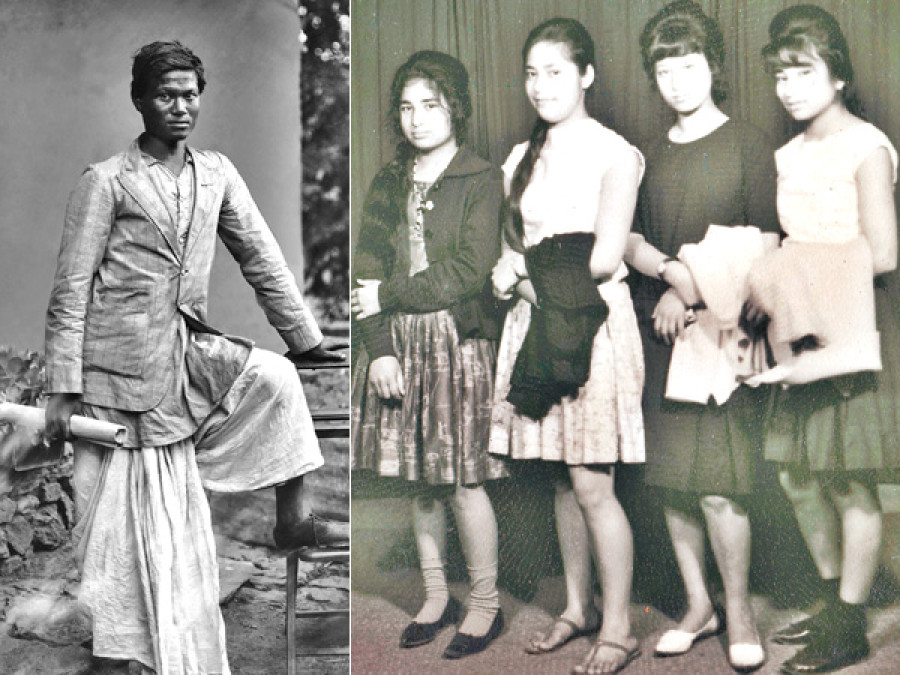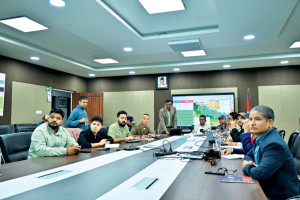Miscellaneous
Time travel through portraits
At the Patan Museum, with images from a bygone era, Nepal Picture Library is creating a portal to a time when a photographic revolution was taking seed
Sujan G Amatya
I have always wanted to time travel, and on May 12, I did.
That day, inside the intricate archaic wooden doors of the Patan Museum, photo.circle and Nepal Picture Library inaugurated Facing the Camera—A History of Nepali Studio Photography exhibition (May 12 - August 12). There, photographs that had stood the test of time were narrating untold tales captured in a hundredth of a second.
Reproduced photos of all sizes, sourced from family albums, photo studios, and personal and institutional collections from across the country, scaled the walls in the exhibit supported by Danish Center for Culture and Development (CKU), and traced the history of Nepali studio photography, all the while surrounded by a narrative of charming individualism of the different time periods which subtly, but gradually, magnified the social progression of a population striving to preserve memories and self-identity.
Walking through the exhibition, listening to bystanders and contributors describe the story behind each photo, reminded me of the time when my family used to huddle together to look at old photo albums—rejoice in nostalgia and share stories of our great-grandparents. Reveling in a pre-Photoshop and pre-Instagram era, the exhibit presents slices of Nepali history that thrived in sepia—before sepia was cool, in vintage filters of today, before it was in vogue, in tangible picture frames, before it was solely used in photo editing software. These artistic relics are entry points into dimensions when analog was the norm, and they took me back in time with aesthetical visions and vantage points into the history of the Nepali people.
Here, the early technicians become the artists who have ended up tracing pieces of history through their lenses in their studios which became stylistic hubs—the sole source through which memories could be tangibly preserved. The people then had never faced a camera. It was up to the photographer to make them comfortable and guide them. Back then, the photographers really did make the picture.
Right off the start, the exhibit evokes a very familiar scene. You can see the deliberate curatorial treatment of the photographs by indulging the various traditional narrow, black, wooden picture frames, alongside decorative silver ones, which compliment the era of the artwork, and display how similarly any ordinary Nepali home—from any cross-section of the society—would treat their photos. Minimal text compliment the photos and explain the evolution of studio photography, in Nepali and English, without clashing for attention. The curatorial choice of replacing brochures with collectible postcards and posters works not only as a marketing strategy, but also “encourages the practice of appreciating and collecting art”, said attendee Sanjeep Maharjan, visual artist and art lecturer.
From the text, you learn how these budding photographers were hired to photograph official ceremonies of the Rana aristocrats, and how Nepal’s first private studios began with handed-down cameras in the 1920s.
You can see the birth of a photographing technique—just like today’s fixation with exposure, white balance, shutter speed, and aperture—and easily connect with the intentions of the photographer and their subjects. “Mimicking the Shah and Rana portraitures, you can see the early photographers placing a strong emphasis on symmetry,” explains writer Pranaya Rana, who helped research the photographs. “Then, the early middle-class subjects copied the postures and stoic expression adopted by the aristocrats and the royalty,” says co-researcher Jebin Gautam, but you could still notice the leeway given to quirky experimentation.
Then came the 1950s, when photographs became mandatory for identity documents. Naturally, studios became more commonplace and through the pictures you can see people rushing to have their pictures made wearing belly-bottom pants while striking Bollywood-esque postures. This era, when the global pop culture seeped into Kathmandu, is plainly evident—a culture that was still mimicking, but evolving, nonetheless, forming a distinct identity. The Dev Anands and the Mala Sinhas mesmerised Nepali audiences, and the women adorned themselves with stylistic nuances while the men reenacted scenes from popular movies. There was a democratic rebellion to the symmetrical technique from the 20s; individualism proliferated. To entice more customers, studios even had catalogues of poses to choose from, like from a hairstylist’s catalogue in salons today.
“This new generation prioritised candid photographs, and broke away from perfected techniques,” explains attendee and photographer Sagar Chettri, where the subjects didn’t look at the camera; they smiled, laughed, played with props (kimonos, fedora hats, traditional garbs, and even the camera itself), and strayed away from group photos. The era also embraced the advances in technology available to the public where the subjects didn’t need to sit still for long periods of time and new ideas of experimentation flourished.
Gradually, you can sense narratives so personal and individualistic, it still makes a powerful mark today—a mark so powerful that when you come to the conclusion of the exhibit, the present state of studio photography, presented in photos on a constant loop on an iPad hung on the wall, feels like an intrusion. The contemporary studio photos are brightly exposed, vivid in colours, sharp in focus, and when placed against these timeless relics of wonder, seem out of place like a fly in your soup. The modern studio photographs seem clinical, formulaic, and crude. Clicking pictures for the sake of it, and not for the love of it, and the exhibition questions if the studios today are even relevant besides taking photos for your passport. Even when you look at the edges of the analog photos and notice the age spots—the watermarks of time—every minute detail has a story to tell. It goes without saying that a photo from the latest iPhone isn’t going to look vintage, but these photos effortlessly are charming. No wonder vintage photography is so popular now and people are trying to capture and frame the purity of the unadulterated photo processes and nostalgia of a different era.
At the very end, the exhibit also elucidates the importance of tangible archiving and documentation, but also works as the perfect promotional strategy for Nepal Picture Library who are striving to document an inclusive history and encouraging families to contribute their photos and stories to the archive, as “many studio photographers have thrown away their slides, negatives, and even equipment, only keeping those with sentimental value. It’s a pity!” concludes Bhushan Shilpakar, co-director of photo.circle, and he is correct: there must be more relics—treasures waiting to be discovered in Nepali photo albums all over the nation.
“We’ve come a long way from the time when people treated us with suspicion when we asked them to contribute photographs from their private collections,” laughs off curator of the show and co-founder of photo.circle, Nayantara Gurung Kakshapati, and by offering curated exhibitions to the Patan Museum, photo.circle is striving to continue its collaborations with the government and other cultural institutions to offer a range of public programming such as talks and guided tours for schools in the next three months, and even providing an alternative approach to teaching history in public and private schools, with a series of books, to bring an inclusive historical narrative into a wider public.
Indeed, this exhibit is an exemplification of those strong narratives. Like navigating a primitive cave of artworks or studying the hieroglyphics that is the subject’s postures, their costumes, their Mona-Lisa smiles, the exhibit serves more than a source of amusement. In an era of pre-Photoshop, these adventurers, behind and in front of the cameras, were very progressive for their time. You get to appreciate how much technology has evolved for contemporary photographers. Gradually, you can see when photography jumped the border from the upper, elite class, into the lives of the average citizenry, when technologies evolved, and when the public utilised the medium of photography to record themselves and convey their aspirations, desires, and identity. These captured moments would have been lost to time if it hadn’t been for photo.circle’s initiative, and the exhibit stands as an opposing testament to the tyranny of time and death, and our vulnerable mortal state.
Is immortality achievable? Yes, here it is.
These photos are now a part of our Nepali artistic landscape. In a cultural kaleidoscope, it announces the birth of an era where making a photograph was more important than taking one. The timeless photographs celebrate the everyday people, their journey, the country’s journey, and ends with an attestation that art can manifest in anyone.
Amatya is a Project Associate at Siddhartha Arts Foundation




 21.12°C Kathmandu
21.12°C Kathmandu










